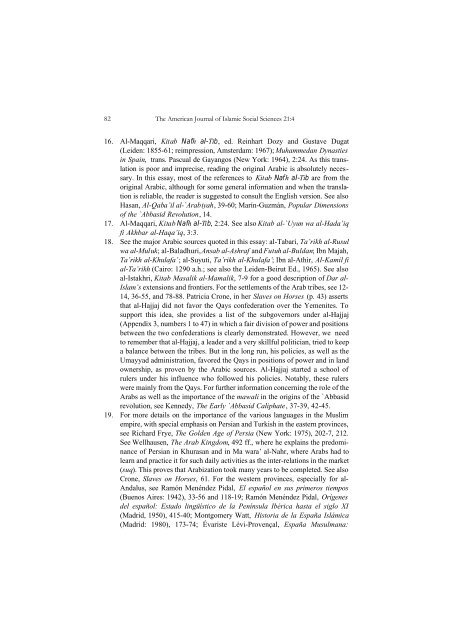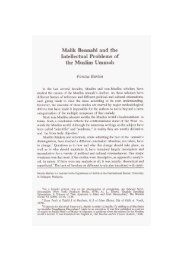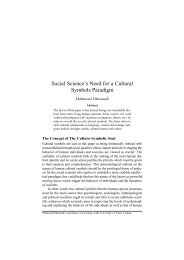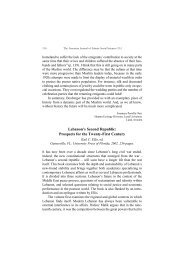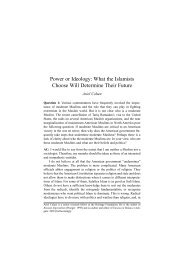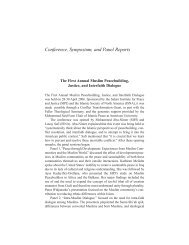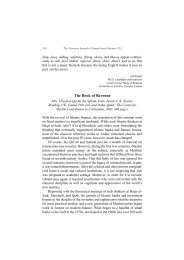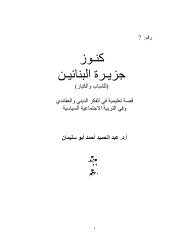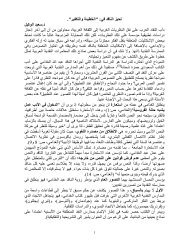Arab Tribes, the Umayyad Dynasty, and the `Abbasid ... - Epistemology
Arab Tribes, the Umayyad Dynasty, and the `Abbasid ... - Epistemology
Arab Tribes, the Umayyad Dynasty, and the `Abbasid ... - Epistemology
Create successful ePaper yourself
Turn your PDF publications into a flip-book with our unique Google optimized e-Paper software.
82 The American Journal of Islamic Social Sciences 21:4<br />
16. Al-Maqqari, Kitab Nafh al-Tib, ed. Reinhart Dozy <strong>and</strong> Gustave Dugat<br />
(Leiden: 1855-61; reimpression, Amsterdam: 1967); Muhammedan Dynasties<br />
in Spain, trans. Pascual de Gayangos (New York: 1964), 2:24. As this translation<br />
is poor <strong>and</strong> imprecise, reading <strong>the</strong> original <strong>Arab</strong>ic is absolutely necessary.<br />
In this essay, most of <strong>the</strong> references to Kitab Nafh al-Tib are from <strong>the</strong><br />
original <strong>Arab</strong>ic, although for some general information <strong>and</strong> when <strong>the</strong> translation<br />
is reliable, <strong>the</strong> reader is suggested to consult <strong>the</strong> English version. See also<br />
Hasan, Al-Qaba’il al-`<strong>Arab</strong>iyah, 39-60; Marín-Guzmán, Popular Dimensions<br />
of <strong>the</strong> <strong>`Abbasid</strong> Revolution, 14.<br />
17. Al-Maqqari, Kitab Nafh al-Tib, 2:24. See also Kitab al-`Uyun wa al-Hada’iq<br />
fi Akhbar al-Haqa’iq, 3:3.<br />
18. See <strong>the</strong> major <strong>Arab</strong>ic sources quoted in this essay: al-Tabari, Ta’rikh al-Rusul<br />
wa al-Muluk; al-Baladhuri, Ansab al-Ashraf <strong>and</strong> Futuh al-Buldan; Ibn Majah,<br />
Ta’rikh al-Khulafa’; al-Suyuti, Ta’rikh al-Khulafa’; Ibn al-Athir, Al-Kamil fi<br />
al-Ta’rikh (Cairo: 1290 a.h.; see also <strong>the</strong> Leiden-Beirut Ed., 1965). See also<br />
al-Istakhri, Kitab Masalik al-Mamalik, 7-9 for a good description of Dar al-<br />
Islam’s extensions <strong>and</strong> frontiers. For <strong>the</strong> settlements of <strong>the</strong> <strong>Arab</strong> tribes, see 12-<br />
14, 36-55, <strong>and</strong> 78-88. Patricia Crone, in her Slaves on Horses (p. 43) asserts<br />
that al-Hajjaj did not favor <strong>the</strong> Qays confederation over <strong>the</strong> Yemenites. To<br />
support this idea, she provides a list of <strong>the</strong> subgovernors under al-Hajjaj<br />
(Appendix 3, numbers 1 to 47) in which a fair division of power <strong>and</strong> positions<br />
between <strong>the</strong> two confederations is clearly demonstrated. However, we need<br />
to remember that al-Hajjaj, a leader <strong>and</strong> a very skillful politician, tried to keep<br />
a balance between <strong>the</strong> tribes. But in <strong>the</strong> long run, his policies, as well as <strong>the</strong><br />
<strong>Umayyad</strong> administration, favored <strong>the</strong> Qays in positions of power <strong>and</strong> in l<strong>and</strong><br />
ownership, as proven by <strong>the</strong> <strong>Arab</strong>ic sources. Al-Hajjaj started a school of<br />
rulers under his influence who followed his policies. Notably, <strong>the</strong>se rulers<br />
were mainly from <strong>the</strong> Qays. For fur<strong>the</strong>r information concerning <strong>the</strong> role of <strong>the</strong><br />
<strong>Arab</strong>s as well as <strong>the</strong> importance of <strong>the</strong> mawali in <strong>the</strong> origins of <strong>the</strong> <strong>`Abbasid</strong><br />
revolution, see Kennedy, The Early <strong>`Abbasid</strong> Caliphate, 37-39, 42-45.<br />
19. For more details on <strong>the</strong> importance of <strong>the</strong> various languages in <strong>the</strong> Muslim<br />
empire, with special emphasis on Persian <strong>and</strong> Turkish in <strong>the</strong> eastern provinces,<br />
see Richard Frye, The Golden Age of Persia (New York: 1975), 202-7, 212.<br />
See Wellhausen, The <strong>Arab</strong> Kingdom, 492 ff., where he explains <strong>the</strong> predominance<br />
of Persian in Khurasan <strong>and</strong> in Ma wara’ al-Nahr, where <strong>Arab</strong>s had to<br />
learn <strong>and</strong> practice it for such daily activities as <strong>the</strong> inter-relations in <strong>the</strong> market<br />
(suq). This proves that <strong>Arab</strong>ization took many years to be completed. See also<br />
Crone, Slaves on Horses, 61. For <strong>the</strong> western provinces, especially for al-<br />
Andalus, see Ramón Menéndez Pidal, El español en sus primeros tiempos<br />
(Buenos Aires: 1942), 33-56 <strong>and</strong> 118-19; Ramón Menéndez Pidal, Orígenes<br />
del español: Estado lingüístico de la Península Ibérica hasta el siglo XI<br />
(Madrid, 1950), 415-40; Montgomery Watt, Historia de la España Islámica<br />
(Madrid: 1980), 173-74; Évariste Lévi-Provençal, España Musulmana:


